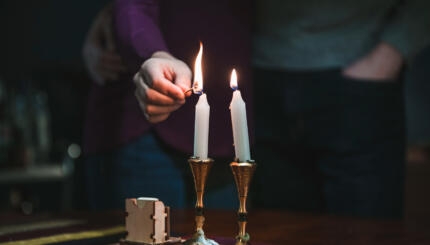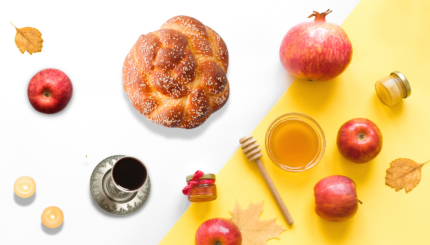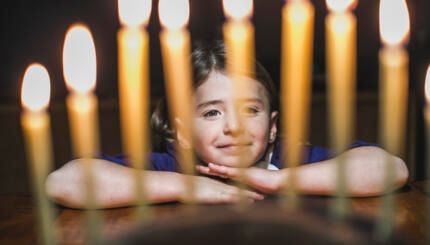As a ceremonial object or art, the candle is generally overlooked, yet it has great significance. Whether intended for practical purposes such as providing light, or for more evocative, quasi-magical ends, such as rekindling the winter sun, almost every festival and celebration incorporates the use of candles at some point.
The Significance of Fire in Judaism
Fire is universally recognized as one of the basic elements of the world. It is mysterious, frightening, mesmerizing. Its attraction is almost irresistible. In the Kabbalah (Jewish mysticism), the image of a multicolored flame emanating from a candle is taken as a metaphor for God’s relation to the world and man. The flame is a single entity, yet it appears to be undergoing constant change. The flame adheres to, relies on and appears to emanate from the candle, yet is a distinct and separate entity. The white interior of the flame is constant, but its exterior is always in motion and changes color.
Reducing fire to a few metaphors, however, robs it of its natural power and mystique. Fortunately the tradition, by incorporating the lighting of candles into the celebratory cycle in a number of different ways [e.g., Shabbat candles, Havdalah (at the end of Shabbat), Hanukkah candles, memorial candles], left open the possibilities for recognizing the many potentialities of fire. It is for us to rediscover those potentialities and allow them to “illumine our eyes.”
On Friday night, one is required to light candles in the house for the sake of shalom bayit (harmony in the home) and oneg Shabbat (Sabbath joy). The candles ought to be in the room where the Sabbath meal is to be eaten.
How to Light the Candles
The exact time when candles are lit varies each week depending on the time the sun sets. (Find this week’s Shabbat candle lighting times here.)
Women traditionally light candles, but in liberal communities candle lighting can be done by any Jewish adult.
Candles may be lit, at the earliest, 1-1/4 hours before sunset, but the [customary] time is up to 18 minutes before sunset. If the [traditional 18-minute] time limit cannot be met, candles may be lit during the 18 minutes immediately preceding sunset.
At least two candles should be lit. These represent “shamor” [“keep”] and “zakhor” [“remember”], the first words of the commandments [in the two Ten Commandments passages in the Torah] concerning Shabbat (Exodus 20:8; Deuteronomy 5:12). They also symbolize the unity underlying all apparent duality, such as man and woman, body and soul, speech and silence, creation and revelation.
It is permissible to light more than two candles. In fact, it is considered particularly meritorious to do so. This is implied in an interpretation of “And God blessed the seventh day” (Genesis 2:3). “With what did he bless it? Light.”
Some people light an additional candle for each child in the family. Once you’ve lit a certain number, it is a custom never to decrease that number.
Students away from home should light candles for themselves, as they are no longer within the household of their parents.

Blessing the Candle Lighting
The ritual of lighting the candles involves:
1. The actual lighting of the candles
2. Drawing the hands around the candles and toward the face from one to seven times (three is most common)
3. Covering the eyes with the hands
4. Saying the blessing
Barukh atah Adonai Eloheinu melekh ha’olam asher kid’shanu b’mitzvotav v’tzivanu l’hadlik ner shel shabbat.
 Blessed are You, Lord our God, Ruler of the Universe, who has sanctified us with commandments, and commanded us to light Shabbat candles.
Blessed are You, Lord our God, Ruler of the Universe, who has sanctified us with commandments, and commanded us to light Shabbat candles.
The halacha for this [i.e., the method prescribed in Jewish law] is a bit complicated. A blessing must [normally] be said before an act. However, since the blessing over the Shabbat candles is also the act which initiates Shabbat, it is forbidden to light a fire after the blessing is said [because of the traditional restriction against kindling a flame on Shabbat]. To get over this bind, one lights the candles and then covers one’s eyes while saying the blessing. When the eyes are opened, the already lit candles are enjoyed for the first time, as it were, therefore both completing the blessing and not violating Shabbat.
There are several intentions associated with the waving of the hands around the candles: it serves to usher in the Shabbat Bride as the light of Shabbat fills the room and surrounds the person; it symbolizes the culmination of the six days of creation into the seventh day of rest; it draws the warmth and light inside oneself.
After saying the blessing, you can softly utter prayers for yourself or others.
You should not make use of the light (e.g., by eating or reading by it); otherwise it [may be considered] a wasted and invalidated blessing.
If there are no candles available, you can make the blessing over electric lights or gas (e.g., camping lanterns).
From The Jewish Catalog, reprinted with permission from the Jewish Publication Society.
Sign up for My Jewish Learning’s RECHARGE, a weekly email with a collection of Shabbat readings and more to enhance your day of rest experience.
Adonai
Pronounced: ah-doe-NYE, Origin: Hebrew, a name for God.
halacha
Pronounced: hah-lah-KHAH or huh-LUKH-uh, Origin: Hebrew, Jewish law.
Shabbat
Pronounced: shuh-BAHT or shah-BAHT, Origin: Hebrew, the Sabbath, from sundown Friday to sundown Saturday.



